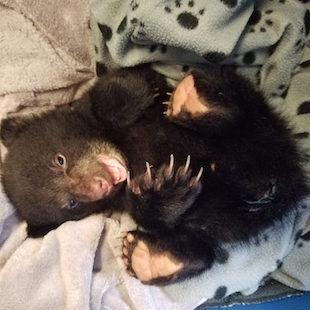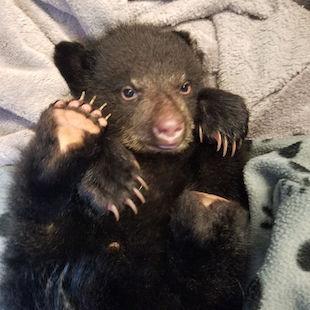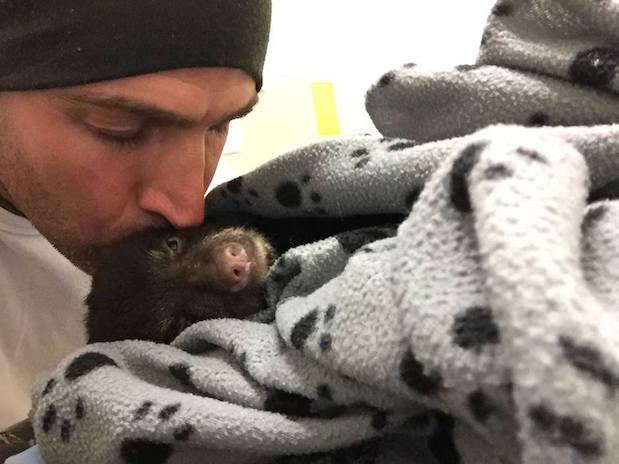
An American bloke who saved a baby bear cub from almost certain death accidentally sparked a huge debate about human interference with animals.
Corey Hancock, 41, was hiking a remote trail near Oregon‘s Santiam River last Monday evening, when he came across a baby black bear cub lying face-up in the meadow. It was emaciated, soaking wet, and barely breathing.
“He wasn’t two feet off the trail, laying there on his back, seeming by all appearances to be dead,” Hancock wrote on Facebook. “His lips were blue. His eyes were open, but unmoving and hazy. The rain was pouring down, drenching his belly. I might have seen a shallow breath.
“Now, I’ve trained my whole life to be observant of my environment, to notice the small details along my path. This cub definitely hadn’t been there when I’d passed a half hour earlier. So where did he come from?
“A fear started to hit me. Wouldn’t his mother be close by? This was the kind of situation that ends up in documentaries about animal attacks. How many people have been mauled after accidentally encountering a black bear cub on the trail? I’ve hiked all over the Pacific Northwest, and never come across a bear before. It wasn’t a possibility I’d ever given much thought to, even though I’d seen signs of their presence on occasion. I definitely wasn’t prepared to deal with a protective mama.”
He retreated and waited 10-minutes for any sign of the mother (who would have certainly murdered him, if she’d been around), then wrapped the lil’ cub up in his flannel shirt and rainproof sack and sprinted the 2.4km to his car.
The cub – which he nicknamed Elkhorn – arrived at the wildlife centre “near death”.
“Examining him in the Turtle Ridge facility, Mary [a worker at the centre] could see right away that the cub was near death,” Hancock wrote. “He should have had a lot more fat on his body. He was starving and dehydrated, and would have had to have been in this condition for some time to end up so thin and weak. Mary put Elkhorn on a heating pad and injected him with electrolyte fluids, which we massaged into his deeper tissues. Together, she and I worked to warm him up, and hydrate him. Even though he’d been wrapped in my flannel, and inside the warm interior of my car for the drive back to town, Elkhorn’s paws were still as cold as though he’d been in a refrigerator.”
Nearly 12 hours later, Elkhorn was showing “significants signs of improvement”, and the next day was turned over to the Oregon Department of Fish and Wildlife (ODFW).


Photos and news of Elkhorn’s progress were shared far and wide on social media, prompting a fierce debate as to whether or not Hancock should have rescued the cub in the first place.
Part of that debate was fanned along by early media reports reminding readers that removing an animal from the wild can result in a Class A misdemeanour, which carries a maximum charge of $8,213 (US $6,250) and up to one year in prison.
“We advise people to never assume a young animal is orphaned unless they saw the mother die,” said ODFW spokesperson Michelle Dennehy to Oregon Live. “It is quite common for young to temporarily be left alone in the wild.
“We see this happen a lot in the spring, with all sorts of young animals including birds, deer fawns and elk calves, and even cougar kittens, getting picked up because people assume they are orphaned.
“Removing young animals from the wild is not a good thing to do for them. These animals miss the chance to learn important survival skills from their parent.”
And as she later told the Washington Post:
“Every year we see deer fawns and bear cubs and cougar kittens removed from the wild because people assume the animal is orphaned when the mother is just eating or doing something else.”
Some people even compared Elkhorn’s rescue to the baby bison who died last year after tourists in Yellowstone thought the animal was cold and so put it in the back of their car. The mother bison later rejected her baby thanks to the human contact, leaving park officials with no choice but to euthanise it.
“Apparently, because I’d made the rescue effort so public over Facebook, Elkhorn’s story had gained a lot of attention overnight, both positive and negative,” Hancock wrote. “My message boards were being flooded with all kinds of malicious notes sent by people who had no idea what actually occurred. Some among them must have alerted the ODFW.”
However, most people were absolutely on Hancock’s side – including the sanctuary.

“While I can appreciate why the press would include [the ODFW’s] official position in their reports, the reality is that Elkhorn was not a cub who’d been waiting while his mother ran out for groceries,” wrote Hancock.
“Far more likely, there was no mother. He wouldn’t have come to be in the condition that I found him in if there had been. Maybe he got separated from her, and remained lost for several days before I came upon him. Or perhaps something tragic happened to his mom. He could have simply been abandoned. I don’t know. Nor does anyone else. But regardless, my encounter was nothing like the kind of scenarios that were being described. Elkhorn would have died that evening, for sure, if I didn’t take the action that I did.”

Oh yeah – and police issued Hancock with a warning, but decided not to cite him.
You can read his full account of events below.
Photos: Corey Hancock / Facebook.



